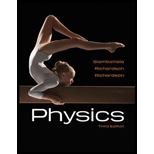
Concept explainers
Check whether the wavelength of the x-rays and the electron is same and also check whether the diffraction pattern will be same if their energies are the same.
Answer to Problem 1CQ
Diffraction pattern depends on the wavelength and since wavelength is same both electron and photon produce the same diffraction pattern.
Same energy photon and electron doesn’t produce same diffraction pattern.
Explanation of Solution
The angle of diffraction is same in both the electron diffraction and the x-ray diffraction experiments.
Write the condition for diffraction of x-rays
Here,
Since
Thus, the wavelength of the x-rays and electrons is the same given the diffraction maxima is same for both.
Consider the energy of the photon and the electron to be the same.
Write the expression for energy of the photon
Here,
Write the relativistic expression for energy of the electron
Here,
Rearranging (III) for
Write the expression for de Broglie wavelength of the electron
Considering
From (VI),
Since, the wavelengths are not the same they cannot produce the same diffraction pattern.
Want to see more full solutions like this?
Chapter 28 Solutions
Physics - With Connect Access
 College PhysicsPhysicsISBN:9781305952300Author:Raymond A. Serway, Chris VuillePublisher:Cengage Learning
College PhysicsPhysicsISBN:9781305952300Author:Raymond A. Serway, Chris VuillePublisher:Cengage Learning University Physics (14th Edition)PhysicsISBN:9780133969290Author:Hugh D. Young, Roger A. FreedmanPublisher:PEARSON
University Physics (14th Edition)PhysicsISBN:9780133969290Author:Hugh D. Young, Roger A. FreedmanPublisher:PEARSON Introduction To Quantum MechanicsPhysicsISBN:9781107189638Author:Griffiths, David J., Schroeter, Darrell F.Publisher:Cambridge University Press
Introduction To Quantum MechanicsPhysicsISBN:9781107189638Author:Griffiths, David J., Schroeter, Darrell F.Publisher:Cambridge University Press Physics for Scientists and EngineersPhysicsISBN:9781337553278Author:Raymond A. Serway, John W. JewettPublisher:Cengage Learning
Physics for Scientists and EngineersPhysicsISBN:9781337553278Author:Raymond A. Serway, John W. JewettPublisher:Cengage Learning Lecture- Tutorials for Introductory AstronomyPhysicsISBN:9780321820464Author:Edward E. Prather, Tim P. Slater, Jeff P. Adams, Gina BrissendenPublisher:Addison-Wesley
Lecture- Tutorials for Introductory AstronomyPhysicsISBN:9780321820464Author:Edward E. Prather, Tim P. Slater, Jeff P. Adams, Gina BrissendenPublisher:Addison-Wesley College Physics: A Strategic Approach (4th Editio...PhysicsISBN:9780134609034Author:Randall D. Knight (Professor Emeritus), Brian Jones, Stuart FieldPublisher:PEARSON
College Physics: A Strategic Approach (4th Editio...PhysicsISBN:9780134609034Author:Randall D. Knight (Professor Emeritus), Brian Jones, Stuart FieldPublisher:PEARSON





